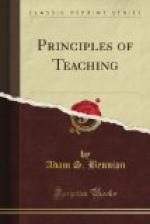The fourth assurance in the matter of developing spirituality is the consistent performance of one’s religious obligations. The complaint is often made that teachers in a particular organization will meet their classes regularly, but that done they seem to consider their religious duties discharged. Teaching does not excuse a person from attending the other services required of Latter-day Saints. He is asked to attend Sacrament meetings, Priesthood meetings, Union meetings, special preparation meetings—they are all essential to the full development of the Spirit of the Gospel, which is the spirit of teaching. The teacher may rightly expect to be sustained only as he sustains those who preside over him.
“For with what judgment ye
judge, ye shall be judged: and with what
measure ye mete, it shall be measured
to you again.” (Matt. 7:2.)
And finally, if we would enjoy the spirit of our work we must familiarize ourselves with the Word of the Lord. To read it is to associate in thought with Him. His Spirit pervades all that He has said, whether in ancient or modern times. One of our apostles frequently remarked that if he would feel fully in touch with the spirit of his calling he must read regularly from the Doctrine & Covenants. “That book keeps me attuned as no other book can.” It is not given to us to associate here with the Master, but through His recorded words we can live over all that He once lived. Thereby we not only come really to know what He would have us do, we partake of a spirit that surpasses understanding.
“Search the scriptures, for in them ye think ye have eternal life.”
As for attainment in other matters involved in the teaching process, the teachers who attended the course at the Brigham Young University were agreed that regular practice in the following processes will insure marked growth and development:
1. The taking of a personal inventory at regular intervals. “Am I the kind of teacher I should like to go to?” starts an investigation full of suggestiveness. The qualities listed in chapter four constitute a reference chart for analysis. A teacher can become his own best critic if he sets up the proper ideals by way of a standard. A teacher in one of our Church schools in Idaho carried out an interesting investigation during the year 1919-1920. Anxious that he should not monopolize the time in his recitations, he asked one of his students to tabulate the time of the class period as follows:
Number of questions asked by teacher.
Number of questions asked by pupils.
Amount of time consumed by teacher.
Amount of time consumed by pupils.
He was astonished to discover that of the forty-five minutes given to recitation he was regularly using an average of thirty-two minutes. Similar investigations can be carried on by any interested teacher.
2. Contact with the best in life. It is a fundamental law in life that life is an adaptation to environment. The writer has been interested in observing the force of this law as it affects animal life. Lizards in Emery county are slate-gray in color that they may be less conspicuous on a background of clay and gray sandstone; the same animals in St. George take on a reddish color—an adaptation to their environment of red sandstone.




